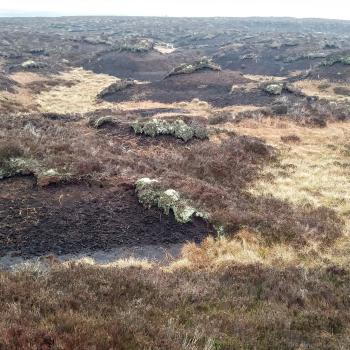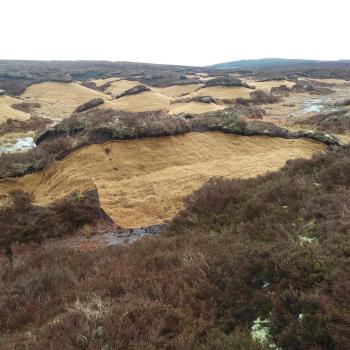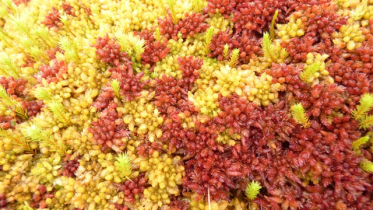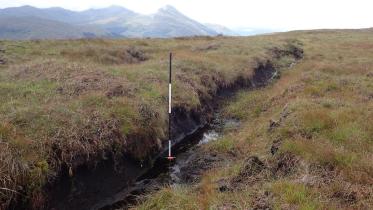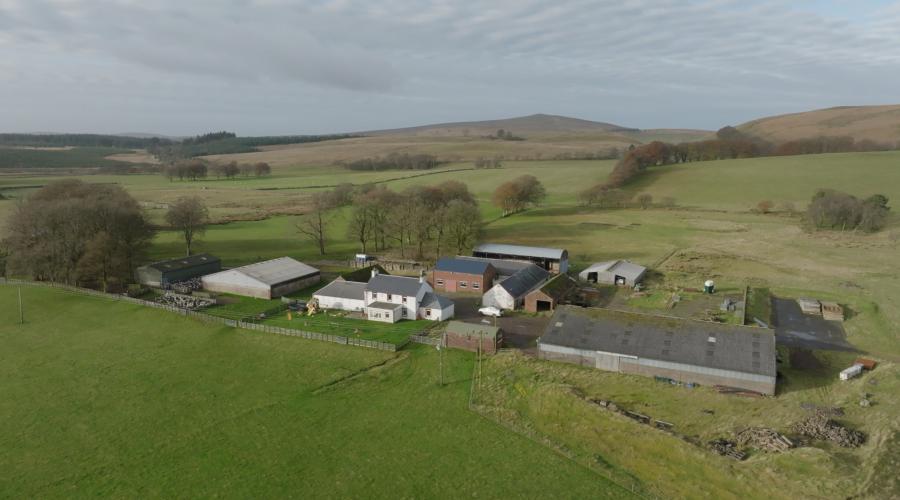
Peatland ACTION case study: What’s the connection between peat and sheep?

What’s the connection between peat and sheep?
The answer lies in creating a safer and more productive landscape for livestock, leading to a more successful sheep farming business.
Tardoes Farm
Tardoes Farm is a sheep farm that covers 2,023 hectares in the Muirkirk Uplands. Historic drains had over time resulted in extensive erosion of the blanket bog that makes up much of the landholding. This had left swathes of bare peat and deep gouges in the hillsides, significantly reducing the availability of good grazing, and creating death traps for lambs and adult sheep alike. Happily for owners David and Cora Cooper, the fact that the farm sits within the Muirkirk Uplands SSSI/Muirkirk and North Lowther Uplands Special Protection Area (SPA) attracted the interest of RSPB Scotland, who were looking for peatland restoration projects to support as part of the Cooperation Across Borders for Biodiversity (CABB) Interreg Project. The resulting collaboration between Tardoes Farm, RSPB Scotland and NatureScot Peatland ACTION led to a very successful, three-phase project that has put over 800ha of damaged peatlands on the road to recovery—a win-win for the business as well as for biodiversity and climate change.
The project
David and Cora Cooper bought Tardoes Farm over 20 years ago. They manage it with a low input, low maintenance system, using Herdwicks and Welsh Mountain sheep, with mob rotational grazing to ensure they protect the health of the land as well as the health and wellbeing of their stock.
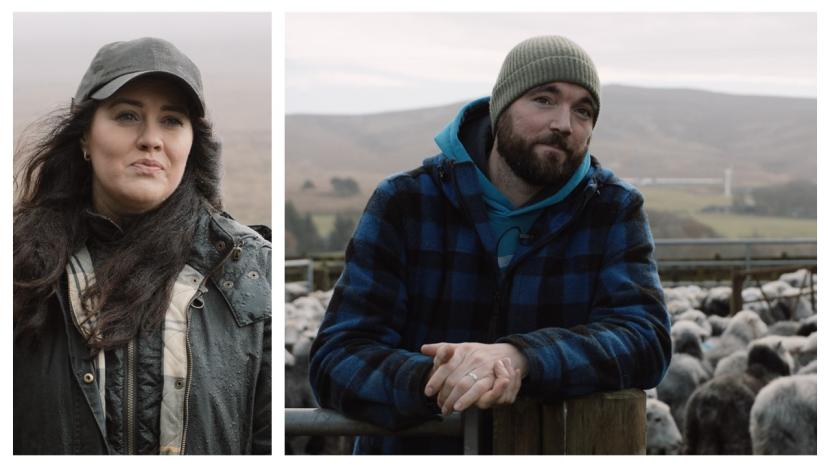
Cora and David Cooper graze over 5000 sheep (3600 ewes) on their hill farm.
©Peatland ACTION/Swift Films
However over time they realised that the extensive drains that were installed across their land long before they acquired it had created significant erosion, with deep gulleys and bare peat hags. These led to high levels of black loss of both lambs and adult sheep, and much depleted grazing where the vegetation couldn’t grow or couldn’t be accessed safely. This was having an impact on the profitability of the farm.
Luckily just at this point, in 2018, they were approached by RSPB Scotland, which was looking for suitable sites on designated land to carry out peatland restoration as part of the CABB programme of which it was part. The Coopers accepted the offer enthusiastically when RSPB Scotland’s CABB peatland ecologist and Project Manager Clive Walton suggested he could manage the peatland restoration work on their behalf, funding the restoration work through a Peatland ACTION grant application.
This began a three-phase restoration project that saw over 800ha of the most damaged peatlands on the Cooper’s farm put on the road to recovery between 2019—2021. Over that time contractors used a wide range of techniques to block the drains and revegetate the hags and gullies, including ditch reprofiling, hagged bank reprofiling, peat, plastic, pile, timber, wide and narrow composite, and mineral damming, applying pegged coir matting for bare peat stabilisation, and installing peat bunds.
The Coopers explained that their grazing pattern was still in operation before, during and after the restoration with no stock reduction. There was no negative impact at all on the farming operations during the project.
In total over 75,000m of ditches have been blocked, and over 20,000m of hags and gullies reprofiled. Pools and ditches were reprofiled to approximately 35 degree slopes so that the sheep could get out easily and wouldn’t get stuck.
Tardoes Farm peatland restoration - Challenges
A project of this scale and complexity in this upland location was intrinsically challenging. The ground work for the first phase, for example, had to be completed in a tight three month period in challenging winter conditions, required plant and materials to be sourced and transported, and infrastructure made good. The engineering and river catchment restoration experience of the contractor involved was an important element in making the project succeed.
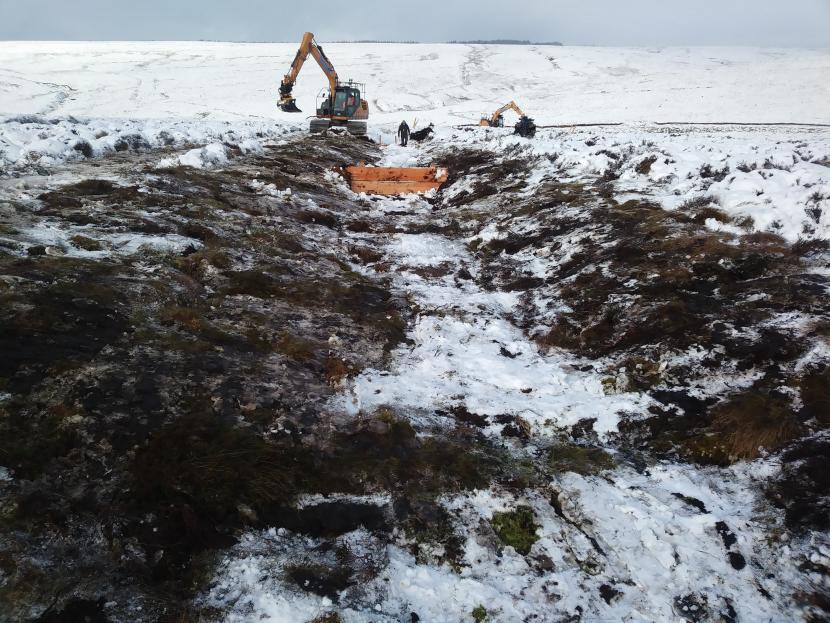
Peatland ACTION funded restoration at Tardoes Farm.
©Clive Walton/RSPB Scotland
The close working relationship between RSPB Scotland’s Clive Walton, Peatland ACTION Project Officer Ewan Campbell and the contractor, Richard Johnson, of MNV Consulting, was also a key element, as together they managed to navigate the difficulties of delivering such a successful project.
Successful outcomes
The Coopers report that since the restoration work has been done the amount of black loss on the hill has significantly reduced, and the grazing has improved markedly. They are also finding it much easier to access the land, making gathering and moving the stock as part of their mob grazing system much more efficient.
Blocking the drains and gullies has also reduced localised flooding on the lower parts of the farm, as this has slowed the flow of water off the hill. As a result of the rewetting work RSPB Scotland reports that the land will now offer much improved habitat for a range of upland birds like red grouse, snipe, and waders, as it will provide a home for much greater numbers of invertebrates - a key food for these species. The contractor also worked on a larger area than originally budgeted for at no extra cost - adding value to the project and helping it to exceed its original targets.
Commenting on the project, David Cooper said: ‘It has categorically been the best thing we have ever done for our farming system’.
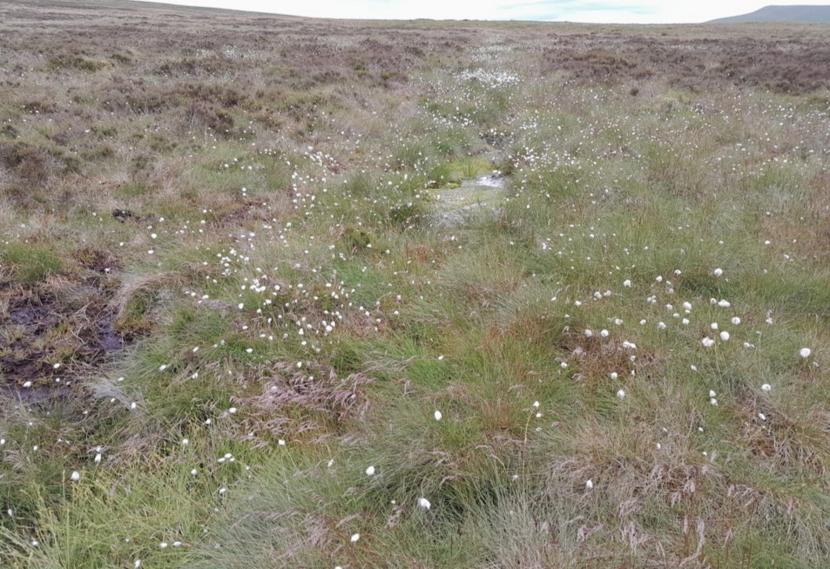
Peatland ACTION funded restoration at Tardoes Farm.
Cotton grass and other peatland plants have started to recolonise the re-profiled edges of a wide ditch. Damming and reprofiling ditches is better for stock as well as biodiversity and climate change.
©Clive Walton/RSPB Scotland
©NatureScot Peatland ACTION/Swift Films
For further information, or to get involved with Peatland ACTION
- We offer funding for suitable peatland restoration projects across Scotland
- We offer, where appropriate, multi-year funding
- We fund up to 100% of the capital costs
- We fund much of the pre-application work, for example, peat depth surveys and feasibility studies
- We have officers who can help design your project, offer advice on restoration management and assist you to complete your application and supporting information.
Peatland ACTION case studies: We demonstrate links between peat condition and: fisheries; grouse; carbon storage; wildlife; landscapes; human history; and so much more.
If you would like to contribute to the on-going work of Peatland ACTION please contact peatlandaction@nature.scot.
For further information: www.nature.scot/peatlandaction


